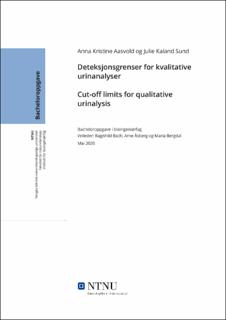| dc.contributor.advisor | Bach, Ragnhild | |
| dc.contributor.advisor | Åsberg, Arne | |
| dc.contributor.advisor | Bergdal, Maria | |
| dc.contributor.author | Aasvold, Anna Kristine | |
| dc.contributor.author | Sund, Julie Kaland | |
| dc.date.accessioned | 2020-07-07T16:09:54Z | |
| dc.date.available | 2020-07-07T16:09:54Z | |
| dc.date.issued | 2020 | |
| dc.identifier.uri | https://hdl.handle.net/11250/2661307 | |
| dc.description.abstract | Analyse av urin ved bruk av urinstrimmel gir semi-kvantitative prøveresultater, og er gradert i nivåene 1+, 2+, 3+ og 4+. Prøveresultatene tolkes likevel ofte til å være enten positive eller negative ut fra deteksjonsgrensen. Ulike produsenter bruker ulike deteksjonsgrenser, men for urinstrimmelen Roche Combur10Test M som ble brukt i denne oppgaven, er den definert som den analyttkonsentrasjonen som gir 90 % sannsynlighet for positivt prøveresultat (C90), en konsentrasjon som tilsvarer 120-180 mg/L. I denne oppgaven skulle analysekvaliteten til testfeltet for protein på urinstrimmelen undersøkes, og dette ble gjort ved å finne deteksjonsgrensen til testfeltet ved avlesning på to ulike reflektometre og sammenlikne de med den deteksjonsgrensen som ble oppgitt av produsenten. Det ble på denne måten undersøkt hvordan urinstrimmelen kunne avleses for å få best analysekvalitet.
Deteksjonsgrensen til testfeltet ble funnet ved å lage en responskurve, som fremstiller sannsynligheten for positivt prøvesvar som funksjon av proteinkonsentrasjonen. Dette ble gjort med utgangspunkt i et datamateriale som ble behandlet ved bruk av probit-regresjon i den statistiske programvaren MedCalc. Datamaterialet ble innhentet i en sammenlikningsstudie utført høsten 2019 på St. Olavs hospital ved seksjon prøvetaking og pasientnær analyse, og sammenliknet semi-kvantitative strimmelresultater fra avlesning på reflektometrene Roche Cobas u411 og Roche Urisys 1100 med kvantitative resultater for protein fra de samme prøvene. I MedCalc ble de semi-kvantitative resultatene plottet mot respektive kvantitative proteinkonsentrasjoner, og to sensitivitetsnivåer ble definert.
I vurderingen av resultatene ble både responskurver og deteksjonsgrenser lagt til grunn. Ved avlesning på Roche Cobas u411 ble deteksjonsgrensen i sensitivitetsnivå 1 funnet til å være 50,60 mg/L, noe som ble vurdert som urealistisk lavt. I sensitivitetsnivå 2 ble den funnet til å være 255,3 mg/L, altså høyere enn den som er angitt av produsenten. Ved avlesning på Roche Urisys 1100 ble både deteksjonsgrensen i sensitivitetsnivå 1 og sensitivitetsnivå 2 funnet til å være høyere enn den som er angitt av produsenten, og tilsvarte henholdsvis konsentrasjonene 280,2 mg/L og 448,6 mg/L. Når det gjelder responskurvene som ble gitt ut for de ulike avlesningene, var den som tilhørte avlesning på Roche Cobas u411 i sensitivitetsnivå 2 den som beskrev best sensitivitet og presisjon. I kombinasjon med at denne avlesningen også ga den deteksjonsgrensen som lå nærmest den som ble oppgitt av produsenten, ble det konkludert med at den ga den beste analysekvaliteten i kombinasjon med urinstrimmelen. | |
| dc.description.abstract | Urinalysis using dipsticks provides semi-quantitative test results, graded at levels 1+, 2+, 3+ and 4+. However, the test results are often interpreted to be either positive or negative based on the value of a cut-off limit. Depending on the manufacturer of the dipstick, different cut-off limits are used. For Roche Combur10Test M, which is the dipstick used in this study, the cut-off limit is defined as the analyte concentration that gives 90 % probability of positive test result (C90), a concentration that equals 120-180 mg/L. In this study the analytical performance of the dipstick’s protein test pad was examined. This was done by finding the cut-off limit of the test pad after reading the dipstick on two different reflectometers and comparing the values with the cut-off limit stated by the manufacturer. By doing this it was examined how the dipstick best should be read to provide a satisfying analytical performance.
The test pad’s cut-off limit was found by creating a response curve, which presents the probability of positive test result as a function of protein concentration. This was done by processing data using probit regression in the statistical software MedCalc. The data was collected in a comparative study performed in the fall of 2019 at St. Olavs hospital, and compared semi-quantitative dipstick results from readings on the reflectometers Roche Cobas u411 and Roche Urisys 1100 with quantitative protein results from the same samples. The semi-quantitative results were plotted against respective quantitative protein concentrations in MedCalc, where two sensitivity levels were defined.
When evaluating the results of the study, both response curves and cut-off limits were considered. Readings done on Roche Cobas u411 found the cut-off limit at sensitivity level 1 to be 50,60 mg/L, which was considered unrealistically low. At sensitivity level 2, it was found to be 255,3 mg/L, which was higher than the cut-off limit stated by the manufacturer. Readings done on Roche Urisys 1100 found both the cut-off limit at sensitivity level 1 and sensitivity level 2 to be higher than the cut-off limit stated by the manufacturer, corresponding to the concentrations 280,2 mg/L and 448,6 mg/L, respectively. Regarding the response curves associated with the different readings, the one associated with the reading on Roche Cobas u411 in sensitivity level 2 was the one that described the best sensitivity and precision. When combined with the fact that this reading also gave the cut-off limit closest to the one stated by the manufacturer, it was concluded that this was the reading that provided the best analytical performance in combination with the dipstick. | |
| dc.publisher | NTNU | |
| dc.title | Deteksjonsgrenser for kvalitative urinanalyser | |
| dc.type | Bachelor thesis | |
